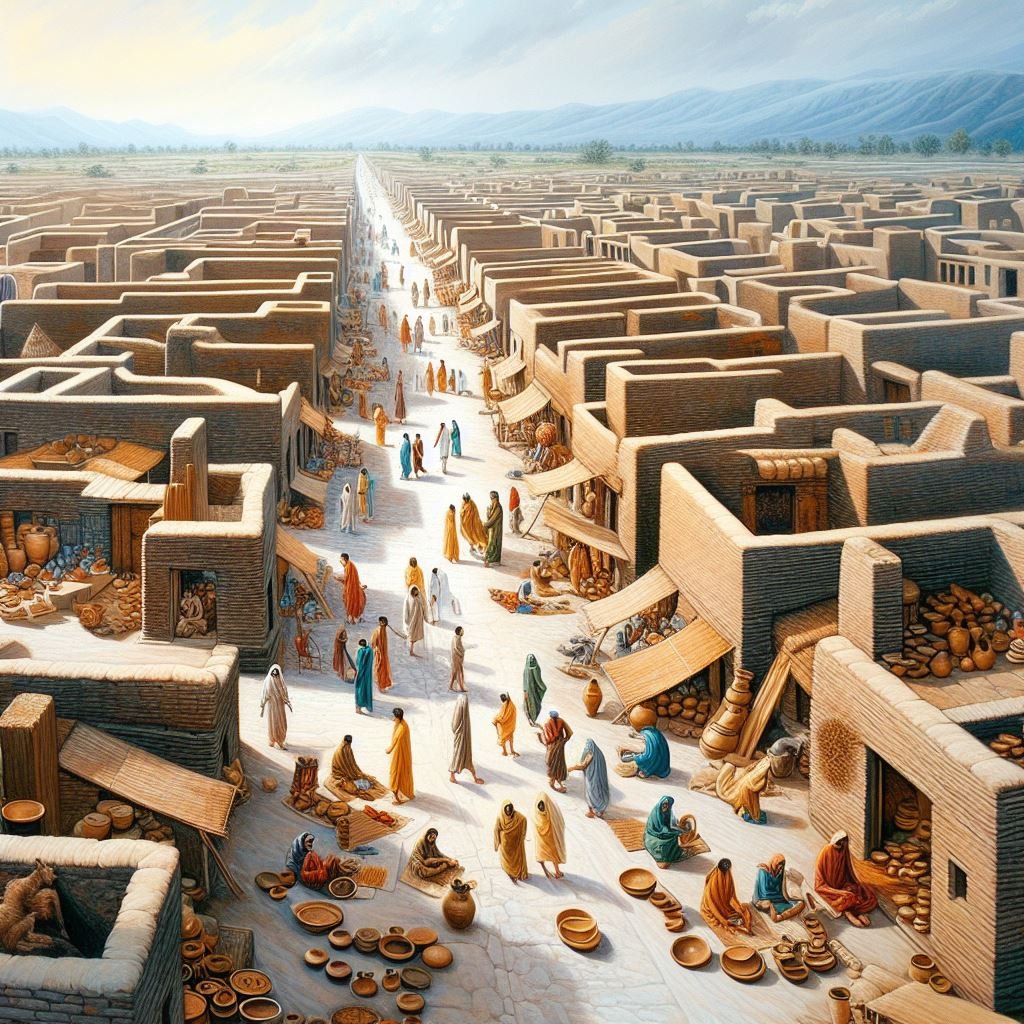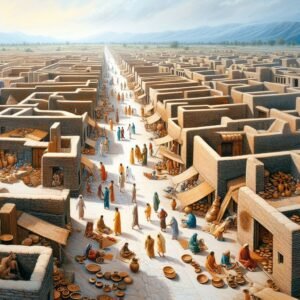India, renowned for its diverse civilizations, proudly includes the complete Indus Valley civilization in its historical heritage. This ancient civilization flourished contemporaneously with renowned civilizations like ancient Egypt and China. Through its advanced urban planning, sophisticated infrastructure, and remarkable craftsmanship, the Indus Valley civilization offers profound insights into early human societies. Its existence alongside other great civilizations underscores the richness and complexity of ancient cultures across the globe.
➤Other Names of Indus Civilization
⬤ Harappan Civilization – Sir John Marshall
⬤ Indus Civilization – As it is located in the Indus river basin.
⬤ Bronze or Bronze Age Civilization – Indus people used bronze.
⬤ Urban Civilization – The first urban civilization that emerged in South Asia.
➤Indus Civilization Excavations
⬤ In 1826, Charles Mason discovered the remains of the Harappan civilization in the mud mounds.
⬤ In 1873, 1876 Alexander Cunningham visited the Harappan mounds and made the initial excavations.
⬤ Sir John Marshall was the Director General of Archeology when he discovered the Indus Civilization.
⬤ Harappa city was discovered by – Dayram Sahani.
Indus Valley Civilization Period Division
The Indus Civilization can be divided into three phases.
1. Early Phase 3500 BC – 2600 BC
2. Peak phase 200 BC – 1900
3. Final phase 1900BC – 1750 BC
(i)Preliminary Stage :-
⬤ Major towns :- Padri (Gujarat), Kalibhangan, Dholavira, Harappa, Balakot, Bhirrana (Haryana), Kot Dji and Gumla.
⬤ Noted historian “Rafiq Meghal” stated that Harappan culture emerged from the culture of Balochistan itself.
(ii) Mature Harappan Phase:-
⬤ This was the urban phase of the Harappan civilization.
⬤ Other Harappan culture towns have similar red and black pottery, terracotta ware, specified brick size 1:2:4. So this phase can be termed as mature or complete Harappan Civilization.
iii) Post Harappan Civilization :-
⬤ In this phase there was no drastic reduction in the number of towns but the size of the towns decreased
⬤ Changes took place in seals, inscriptions on pottery, and weighing stones.
⬤An example of post-Harappan civilizations
Jhukar culture, Aharar culture, Ranapur culture, Malwa culture
Contemporary civilizations
⬤ Civilization of Sumeria (or ) Civilization of Mesopotamia
⬤ Mesopotamia means the region between the two rivers, which is now known as “Iraq”.
⬤ The people of the Harappan civilization maintained trade and cultural relations with the people of the Mesopotamian civilization.
⬤ Egyptian Civilization-developed on the Nile River in Africa.
⬤ Chinese Civilization– flourished in the Hoang Ho River basin. .
⬤ This river is known as “China’s Mourner” because of its frequent floods and damages.
Area
⬤ The Indus Civilization was the most extensive of the contemporary civilizations of that time.
⬤ This is 12 times larger than the combined civilizations of Egypt and Sumeria. Its area is 13 lakh sq. km.
⬤ Northern border – Manda in Jammu and Kashmir. It is situated on the banks of river Chenab.
⬤ Southern border – Dhimabad (MH). It is situated on the banks of river Pravara.
⬤ Eastern border– Alamgir (UP). Yamuna tributary lies on the bank of “Hindan”.
⬤ Western border– Satkajendaro (Pakistan). Located on the bank of Dasht river.
Builders of Indus Valley Civilization
⬤ According to historians, there were mainly 4 races of people living in the Indus Civilization. So they are called mixed culture.
1. Proto Australoid race: The features of this race are seen in the bronze statue of Natyagatte found at Mohenjodara. Acharya Bhasham said that they were in the first stage.
2.Mongoloid race: The features of this race are seen in the clay man figure found at Mohenjo-daro.
3. Alpinoid race: Archeological excavations have found relatives of this race.
4. Mediterranean Race: People of this race were the majority of the Indus Civilization. So they are known as the makers of Indus Civilization. They are called Dravidians because they speak Dravidian language.
Indus Civilization Emergence Theories
Indigenous
⬤ This theory was proposed by “Amalananda Ghosh”. But no one accepted this theory.
Foreign
⬤ Mortimer Wheeler – The Sumerians migrated and formed the Indus Civilization.
⬤ Prof. Rafiq Mughal – Indus Civilization came from Balochistan.
Major cities of the Indus Civilization
Harappa
⬤ Harappa is the city mentioned as ‘Hara Upia’ of Rigveda.
⬤ Items found here
Amma Talli, Nataraja idols, humped bull print, bronze mirrors.
⬤ Harappa is known as “city of granaries”. There are 12 granaries of 6 each in two rows.
⬤ H-shaped tombs were revealed.
Mohenjo Daro
⬤ Mohenjo Daro in Sindhi language means ‘Mound of the Dead’.
⬤ The largest city of the Indus Civilization. It has a population of 35,000 – 41,000. It has been flooded 7 times.
⬤ The Great Bath was discovered here by John Marshall.
⬤ The ‘statue of the bearded priest’ was found here.
⬤ Dancing bronze statue, thread cloth, kolabadda, bullock cart are available.
⬤ To the west of Mahasnana Watika is the largest granary.
⬤ Goddess Mudrika available.
⬤ Wells are more common.
⬤ Stone lingas are exposed.
⬤ The discovery of Stupakara prints suggests that the people here had trade relations with the people of Sumer.
Chanhudaro
⬤ City flooded 3 times
⬤ The only city without a fort
⬤ Evidence of an inkwell, a bronze cart, and a cat were found.
⬤ The statue of ‘Nataraja’ was found here.
Lothal
⬤ In Gujarati Lothal means mound of the dead.
⬤ Major port town and artificial seaport of the Indus Civilization.
⬤ Indus was the main center of maritime trade of the people.
⬤ History of Ancient India The people of Indus who cultivated “rice” for the first time.
⬤ Homagundam, chess board, terracotta horse figurine and a grain of rice was found.
Kali Bhangan
⬤ Kali Bangan means ‘black bangles’
⬤ The ‘Amma Talli Idol’ worshiped by the people of Indus has been found here.
⬤ The oldest “farm” in the Indian subcontinent was found here.
Banwali
⬤ A single city without sewerage.
⬤ There is evidence that barley was cultivated.
Sarkotoda
⬤ Site where horse remains are found.
⬤ Site where evidence of burial in pottery was found.
⬤ An animal unknown to the people of the Indus Civilization was the “Horse”.
Dholaveera
⬤ The only Indus Civilization town with water storage structures.
⬤ Known as the City of Water, Dholavira has been recognized as a UNESCO World Heritage Site in 2021.
Gumla
⬤ The sources of Sarpapuja have been found.
Kot Diji
⬤ Stone arrows are exposed.
Rakhigarhi
⬤ Largest Indus Civilization city in present day India.
Indus Civilization City Building
⬤ The Indus Civilization was primarily an urban civilization.
⬤ Houses in these cities are built on the basis of a “grid system”.
⬤ At present Chandigarh is a grid-based city while Banwali is a non-grid-based city.
⬤ The Indus people used burnt bricks in their constructions.
⬤ They introduced the method of brick stacking (English bonding) for the first time.
⬤ Rulers, priests, and merchants lived in the high ground, while the common people lived in the lowlands.
⬤ However, Chanhudharo did not have a fort so the city was not divided.
⬤ In Dholavira, however, it was built with a different plan into 3 cities namely Upper City, Middle City and Lower City.
⬤ Burnt bricks are used in civil constructions and dried bricks are used for residential buildings. But in Dholaveera, the use of stone is seen.
⬤ The Indus Civilization people took special care in constructing the underground drainage system. But this system is not found in Banavali.
Political system
⬤ D.D. Kosambi—It was a religious kingdom, ruled by priests. –
⬤ According to R.S.Sharma it was a secular state as it was ruled by traders.
⬤ Strong centralized system according to Dixit & Gordon Child.
Economic system
Agriculture
⬤ Indus Civilization was an agricultural based economy.
⬤ The main crops grown by them are barley and wheat. Other crops are cotton,sorghum, pulses, peas and mustard.
⬤ Area where quality barley crop is grown-Banwali.
⬤ The Indus people were the first to grow cotton in the world.
⬤ Main means of transport of Indus people – Bullock Cart(Ekka).
Industries
⬤ Areas where evidence of bead and glass industry has been found- Balakot, Lothal, Chanhudharo.
⬤ Kolabada made of shell is the earliest available – Mohanjadaro.
⬤ The area with the largest available bronze scale is Harappa.
Business and trade
⬤ ”Barter system” adopted in business.
⬤ Means of transport that played a prominent role in trade in the Indus Civilization region- Bullock Cart,Ship.
⬤ Port towns where Indus Civilization trade took place- Lothal, Sarkotoda, Balakot, Sutkazendar.
⬤ Trade and trading areas of the Indus people-Dil Man, Bahrain, Makan.
Major exports
⬤ Important Export – Silver.
⬤ There is evidence that Indus traders used the bird as a compass for their ships.
Weights and Measures
⬤ People of Indus civilization used accurate weights and measures. The weight stone used by them was ‘All Bastar’.
Religious conditions
⬤ The main deity of the Indus people is “Mother”.
⬤ The Indus people completed both male and female genitalia. Evidence of ‘Linga’ worship is found in Mohenjodaro and stone yoni worship is found in Harappa.
⬤ The Peeple tree was the main tree of the Indus civilization.
⬤ Evidence that the Indus people also worshiped snakes has been found in the Gumla region.
⬤ Pashupati Mahadev was the only male deity worshiped by the Indus people.
⬤ The Indus people also worshiped the swastika symbol.
⬤ Indus Civilization area with evidence of partial burials-Banwali
⬤ The city where there is evidence of the practice of burial of ashes with pottery is Rangapur.
Social system
⬤ Indus society was primarily a ‘matriarchal system’.
⬤ Masons held a high position in the society.
⬤ The main pastime of the Indus people – gambling (or) playing dice.
⬤ The most common toy of the Indus people is the cart doll
⬤ The name of the pieces of charcoal used in their time – ‘Shilajata’.
Script
⬤ Another name for the script used by the Indus people is Zooalic
⬤ The main evidence for the study of the Indus script is ‘prints’.
⬤ Because their script is written from left to right and from right to left, it is said that they are not Sarpalekanam or Nagavallikala script.
⬤ Tried to analyze Indus script using computer – Yurizh norozov (Russia).
⬤ The vedic Glossary on Indus Script by Natwar Jha.
Architecture and sculpture arts of the people of Indus Civilization
⬤ Prints have played a prominent role in revealing the history of the Indus Civilization.
⬤ These are made of soft stone called ‘steatite’.
⬤ A lot of prints with bull figure without a hood have been found.
⬤ They mostly made monkey figurines using terracotta.
⬤ They were the first to use silver in the world, bronze being the most widely used metal.
⬤ A statue of a bearded man was discovered at Mohenjodaro. This The statue is one of the most prominent of the Indus Civilization objects.
⬤ Things unknown to the people of the Indus Civilization
Iron, horse, giraffe, lion, sugarcane and pulses.
Fall of the Indus Civilization
⬤ Sir Mortimer Wheeler – The Aryan Invasion
⬤ G.F. Dells – Natural calamities
⬤ R.L. Raikes & Dales – Earthquakes
⬤ D.D.Koshambi -Environmental changes
⬤ Rafiq Mughal – drying up of river Ghaggar-Hakra
A fact that everyone agrees on – the theory of climate change

